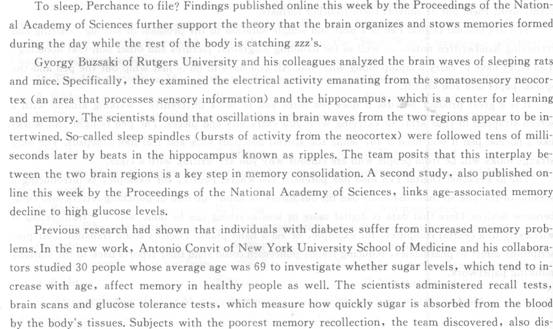 题目内容
(请给出正确答案)
题目内容
(请给出正确答案)
Sleep Lets Brain File MemoriesTo sleep. Perchance to file? Findings published online this
Sleep Lets Brain File Memories
To sleep. Perchance to file? Findings published online this week by the Proceedings of the National Academy of Sciences further support the theory that the brain organizes and stows memories formed during the day while the rest of the body is catching zzz's.
Gyorgy Buzsaki of Rutgers University and his colleagues analyzed the brain waves of sleeping rats and mice. Specifically, they examined the electrical activity emanating from the somatosensory neocortex (an area that processes sensory information) and the hippocampus, which is a center for learning and memory. The scientists found that oscillations in brain waves from the two regions appear to be intertwined. So-called sleep spindles (bursts of activity from the neocortex) were followed tens of milliseconds later by beats in the hippocampus known as ripples. The team posits that this interplay between the two brain regions is a key step in memory consolidation.
A second study, also published online this week, by the Proceedings of the National Academy of Sciences, links age-associated memory decline to high glucose levels.
Previous research had shown that individuals with diabetes suffer from increased memory problems. In the new work, Antonio Convit of New York University School of Medicine and his collaborators studied 30 people whose average age was 69 to investigate whether sugar levels, which tend to increase with age, affect memory in healthy people as well. The scientists administered recall tests, brain scans and glucose tolerance tests, which measure how quickly sugar is absorbed from the blood by the body's tissues. Subjects with the poorest memory recollection, the team discovered, also displayed the poorest glucose tolerance. In addition, their brain scans showed more hippocampus shrinkage than those of subjects better able to absorb blood sugar.
"Our study suggests that this impairment may contribute to the, memory deficits that occur as people age," Convit says. "And it raises the intriguing possibility that improving glucose tolerance could reverse some age-associated problems in cognition." Exercise and weight control can help keep glucose levels in check, so there may be one more reason to go to the gym.
Which of the following statements is nearest in meaning to the sentence "To sleep. Perchance to file?"?
A.Does brain arrange memories in useful order during sleep?
B.Does brain have memories when one is sleeping?
C.Does brain remember files after one falls asleep?
D.Does brain work on files in sleep?
 答案
答案






 {TS}Which of the following statements is nearest in meaning to the sentence“To sleep.Perchance to file?”?
{TS}Which of the following statements is nearest in meaning to the sentence“To sleep.Perchance to file?”?



















